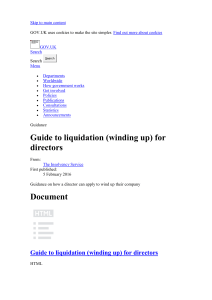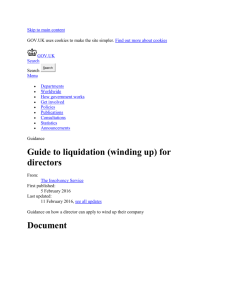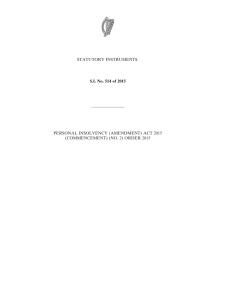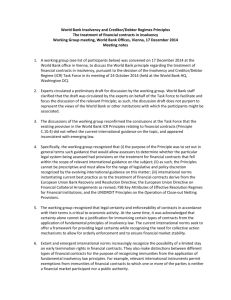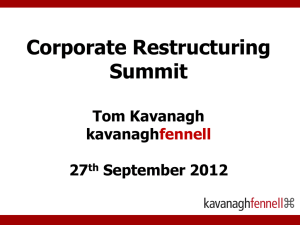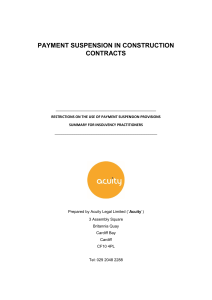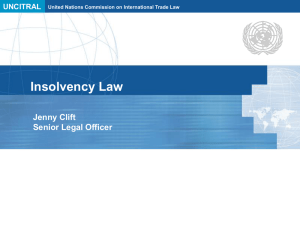CHAPTER 15 - The Insolvency Service
advertisement
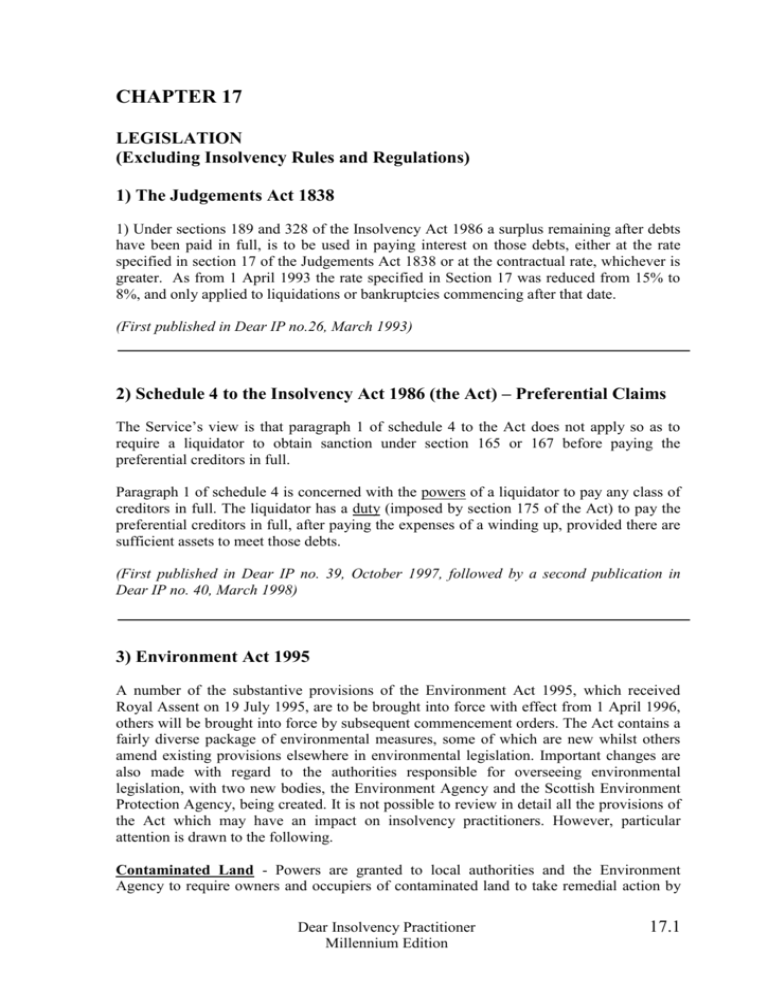
CHAPTER 17 LEGISLATION (Excluding Insolvency Rules and Regulations) 1) The Judgements Act 1838 1) Under sections 189 and 328 of the Insolvency Act 1986 a surplus remaining after debts have been paid in full, is to be used in paying interest on those debts, either at the rate specified in section 17 of the Judgements Act 1838 or at the contractual rate, whichever is greater. As from 1 April 1993 the rate specified in Section 17 was reduced from 15% to 8%, and only applied to liquidations or bankruptcies commencing after that date. (First published in Dear IP no.26, March 1993) 2) Schedule 4 to the Insolvency Act 1986 (the Act) – Preferential Claims The Service’s view is that paragraph 1 of schedule 4 to the Act does not apply so as to require a liquidator to obtain sanction under section 165 or 167 before paying the preferential creditors in full. Paragraph 1 of schedule 4 is concerned with the powers of a liquidator to pay any class of creditors in full. The liquidator has a duty (imposed by section 175 of the Act) to pay the preferential creditors in full, after paying the expenses of a winding up, provided there are sufficient assets to meet those debts. (First published in Dear IP no. 39, October 1997, followed by a second publication in Dear IP no. 40, March 1998) 3) Environment Act 1995 A number of the substantive provisions of the Environment Act 1995, which received Royal Assent on 19 July 1995, are to be brought into force with effect from 1 April 1996, others will be brought into force by subsequent commencement orders. The Act contains a fairly diverse package of environmental measures, some of which are new whilst others amend existing provisions elsewhere in environmental legislation. Important changes are also made with regard to the authorities responsible for overseeing environmental legislation, with two new bodies, the Environment Agency and the Scottish Environment Protection Agency, being created. It is not possible to review in detail all the provisions of the Act which may have an impact on insolvency practitioners. However, particular attention is drawn to the following. Contaminated Land - Powers are granted to local authorities and the Environment Agency to require owners and occupiers of contaminated land to take remedial action by Dear Insolvency Practitioner Millennium Edition 17.1 service of a "remediation notice" setting out what must be done, and by when, to clean up the damage. Default in complying with a remediation notice may lead to the local authority or Agency carrying out the work. Failure to deal with such a notice is an offence and may lead to liability for the authority's or Agency's remediation costs. However, insolvency office-holders will not be guilty of such an offence, nor personally liable for the costs of clearing up, provided the damage requiring remediation is not attributable to any unreasonable act or omission on their part. The full provisions are set out at section 57 of the Act which inserts new sections 78A-78YC into the Environmental Protection Act 1990. Abandoned Mines - Any person operating a mine is required to give six months notice to the Environment Agency or the Scottish Environment Protection Agency, as appropriate, of any proposed abandonment of the mine. The definition of abandonment is very wide and may, for example, include discontinuance of mining activities, cessation of the working of any seam or vein, or the discontinuance of water removal operations. It is a criminal offence to fail to comply with this requirement. Insolvency practitioners appointed, or contemplating appointment, in respect of any insolvent estate which has an interest in a mine will need to be aware of this requirement. An insolvency practitioner's duty to comply with this provision is not removed by a disclaimer made in respect of a mine under insolvency legislation. The full statutory provisions are set out at section 58 and 59 of the Act which insert new sections 91A and B into the Water Resources Act 1991 (England and Wales) and section 30Y and Z into the Control of Pollution Act 1974 (Scotland). Powers of Entry and to Require Information - Powers are given to enforcing authorities (which include the Environment Agency and local authorities), or a person authorised by those authorities, to enter premises for various purposes in connection with pollution control. Information and documents, including extracts from any computerised records, may also be required from any person thought to be capable of supplying that information or those documents. It is an offence to obstruct an enforcing authority, or any duly authorised person, or, without reasonable excuse, to fail to supply information or documents requested. Any insolvency practitioner acting in relation to an estate in respect of which any of these powers is exercised would be obliged to comply with the provisions. The provisions are set out at section 108-110 of the Act. Contact: Mike Edbury, Insolvency Practitioner Section, the Insolvency Service, PO Box 203, 21 Bloomsbury Street, London WC1B 3QW (telephone 020 7291 6771/2) (First published in Dear IP no. 35, April 1996 4) Criminal Procedure and Investigation Act 1996 (The Act) Introduction The disclosure provisions of the Act came into operation on 1 April 1997, and, together with the associated Code of Practice, comprise a new regime for cases where a criminal investigation commenced on or after that date. Dear Insolvency Practitioner Millennium Edition 17.2 Summary of the disclosure regime The Act introduced a three-tier system of disclosure namely: Primary disclosure - the duty of the prosecutor to disclose prosecution material to the defence which, in the opinion of the prosecution, undermines the case for the prosecution against the accused. Primary disclosure is triggered where the accused faces summary trial (i.e. in a Magistrates Court) and pleads not guilty, or the accused is committed, or the case is transferred, for trial by jury. Defence statement – is a statement setting out in general terms the nature of the defence, indicating the matters on which the accused takes issues with the prosecution, and in the case of each matter, the reasons why. A defence statement is compulsory for an accused facing trial by jury, provided that the Prosecution have complied with their primary disclosure duty, and is optional for an accused facing a summary trial. A defence statement must be served on the prosecution within 14 days of primary disclosure being made. Secondary disclosure – as soon as is reasonably practicable following receipt of a defence statement, the prosecution has to provide details of any additional information which had not previously been disclosed and which might reasonably be expected to assist the accused’s defence as set out in the defence statement. In addition, the Code of Practice provides that following a conviction, all material which was relevant to the investigation must be retained for periods which can be broadly outlined as: in the case of a custodial sentence, until six months after the conviction or until that sentence is completed, whichever is the later; in the case of a non-custodial sentence which is to run for a particular period (e.g. a probation order), until that sentence has ended. The effect on the Official Receiver The Act will create additional work for the Official Receiver (OR), who will be required to provide a detailed analysis of material which comes into his possession, or is generated during the course of his dealing with a case, when submitting prosecution reports to the Service’s Headquarters. That analysis will include details of an insolvent’s accounting records, books, papers, etc. Where a criminal investigation/prosecution results from a prosecution report submitted by the OR, material relevant to the investigation will include all books, records, papers, documents etc mentioned above. Following a conviction the OR will have to retain such “relevant material” in line with paragraph 2 above. Dear Insolvency Practitioner Millennium Edition 17.3 The effect on insolvency practitioners Where such records etc have been handed over to an insolvency practitioner (IP), the requirements imposed on the OR above will not be extinguished. The Act itself does not impose requirements upon IPs to maintain and list insolvent’s records, documentation etc and there is no alteration to the existing policy of handing an insolvent’s accounting records to an IP appointed as trustee or liquidator of the insolvent’s estate. The Act places no obligation upon IPs to either retain material or to reveal its existence to an investigator or prosecutor, but it is likely that such requests will be made by investigators. If an investigator believes that an IP may be in possession of material that may be relevant to the investigation, the IP will be notified that an investigation is taking place and will be invited to retain the material in case they receive a request for its disclosure. An accused person may also request access to, or information on, material held by practitioners. In view of the requirements imposed upon the OR outlined in paragraph 3 above, it is essential that an insolvent’s books, papers, etc are accurately maintained, notwithstanding that the material may be in the possession of an IP. Accordingly, IPs are requested wherever possible, to maintain an insolvent's accounting records, etc in the same format in which they are collected, e.g. records should not be re-boxed unless absolutely necessary. Where an IP feels that the records must be re-boxed or re-organised in order to assist his administration, it would assist if a file note could be kept amongst the practitioner’s working papers, recording the date that re-boxing etc occurred, and a brief explanation of the reason why it was required. (First published in Dear IP no. 42, September 1998) __________________________________________________________________ 5) Civil Procedure Rules 1998 New Civil Procedure Rules (CPR) were introduced on 26 April 1999. This will necessitate some amendment of insolvency secondary legislation in areas where that legislation currently makes reference to, and is dependent for its operation on, the Supreme Court Rules or the County Court Rules. General references to the existing court rules will be replaced with reference to the corresponding new rules. Where currently used terms will cease to be used under the CPR (i.e. discovery) they will be replaced by the new term (i.e. disclosure). There will be two new statutory instruments - the Insolvency (Amendment) (No.2) Rules 1999, and the Insolvent Companies (Disqualification of Unfit Directors) Proceedings Rules 1999 - these have been available from HMSO since 16 April 1999. Practitioners should note that the provisions of the CPR will only apply to insolvency proceedings to the extent that they are consistent with the Insolvency Rules. (Enquiries arising from the above should be addressed to Richard Favier on 020 7637 6421). (First published in Dear IP no. 44, April 1999) Dear Insolvency Practitioner Millennium Edition 17.4 6) The Late Payment of Commercial Debts (Interest) Act 1998 The statutory right for small businesses to claim interest from larger businesses and public sector bodies from 1 November 1998 will have implications for insolvency practitioners dealing with proofs of debt and book debts in insolvencies. The Late Payment of Commercial Debts (Interest) Act 1998 provides the right to claim interest when payment is made after the agreed credit period, or 30 days if no credit period has been agreed. The interest rate will be set at 8% above the Bank of England base rate. (First published in Dear IP no. 42, September 1998) _____________________________________________________________________ 7) Education (Student Loans) Act 1990. Teaching and Higher Education Act 1998. Education (Student Support) Regulations 1999. This article seeks to provide information about a change to the status of (some) student loans in the context of bankruptcy. The student loans regime changed with the enactment of the Teaching and Higher Education Act 1998 and the Education (Student Support) Regulations 1999 which came into force on 3 March 1999. Where a student loan is made under the 1999 regulations, it shall not be claimed as part of the bankrupt's estate, either as vesting property, or after acquired property, or as part of an income payment order. An outstanding loan is now not excluded from being a bankruptcy debt, and so will be released on the discharge of the bankrupt. Therefore where at the date of a bankruptcy order the bankrupt has an outstanding debt in respect of a student loan made under the new arrangements, it should be scheduled as a debt in the usual way, with the Student Loans Company Limited of 100 Brothwell Street, Glasgow G2 7JD being added to the list of creditors. This company will submit a claim in cases when the loan was made under the Student Support Scheme but will not submit a claim where the loan was made under the old Student Loans Scheme, i.e. under the former arrangements. The deciding factor is the scheme under which the loan was made, not the date in which, the new regulations came into force, namely 3 March 1999. (First published in part Dear IP no. 43, January 1999) _____________________________________________________________________ 8) Data Protection Act 1998. How we collect and use information? Under the Data Protection Act 1998 (the Act) persons who process personal data (“Data Controllers”) are obliged to tell the people they have information on (“Data Subjects”) certain details about the data held. This article complies with that obligation with regard to the personal data held by the Service relating to Insolvency Practitioners (IPs). Dear Insolvency Practitioner Millennium Edition 17.5 Individual Official Receivers (ORs) and the Secretary of State (SoS) are Data Controllers for the purposes of the Act. Practitioners should also be aware that under the terms of the legislation they may also be “Data Controllers”. ORs and the Service hold information about current and former IPs, and applicants to the SoS for authorisation as IPs, for the purposes of recording details of trustees and liquidators, and also for registration and authorisation purposes. The Service may check information provided by individual IPs, or by a third party, with other information held in-house. Information may also be passed to third parties in order to check its accuracy, or for regulatory or enforcement purposes. As data subjects, individual IPs are entitled to know what information ORs/the SoS hold about them. The Service is not however required to disclose information which would be likely to prejudice the proper discharge by The Service of functions designed to protect members of the public against dishonesty, or other serious misconduct. Any IP wishing to know more about the information held about him or her, or the purposes for which it is held, should contact the Data Protection Liaison Officer (DPLO) at Insolvency Practitioner Section, 21 Bloomsbury Street, London, WC1B 3QW. The DPLO will respond with full details of the type of information that can be provided. The DPLO will also provide a standard data request form for completion and return, together with payment of the relevant fee and appropriate form of identification. Upon receipt of the completed request form and fee the DPLO has 40 days in which to deal with the request. The IP should inform the DPLO, in writing, of any inaccuracy in the information provided. (First Published in Dear IP no. 49, March 2000) 9) Introduction of Some of the Pensions and Bankruptcy Provisions of the Welfare Reform and Pensions Act 1999 The following provisions of the Welfare Reform and Pensions Act 1999 came into force on 29 May 2000 and will not apply retrospectively:Section 11 (1), (2), (3) and (11); Section 13 (1) and (2); Section 18 (so far as it relates to paragraph 1 and 2 of Schedule 2); and Schedule 2 – paragraph 1 and 2 Section 11 (12) of the Act will come into force on 1 December 2000. Section 11 excludes all right under ‘approved pension arrangements’ (as defined in that Section) from the bankrupt’s estate. Section 11 will apply to proceedings where the bankruptcy petition was presented on or after 29 May 2000. The new provisions will not affect the making of income payments orders under Section 310 of the Insolvency Act 1986 or Section 32(2) of the Bankruptcy (Scotland) Act 1985. Dear Insolvency Practitioner Millennium Edition 17.6 Pensions payments can be taken into account when calculating a bankrupt’s income for the purposes of an income payment order. Regulations that will allow the recovery of excessive contributions from protected pensions and to protect less common types of pensions from seizure on bankruptcy should be introduced early in the next session of Parliament. (First published in Dear IP no. 50, June 2000) Dear Insolvency Practitioner Millennium Edition 17.7
